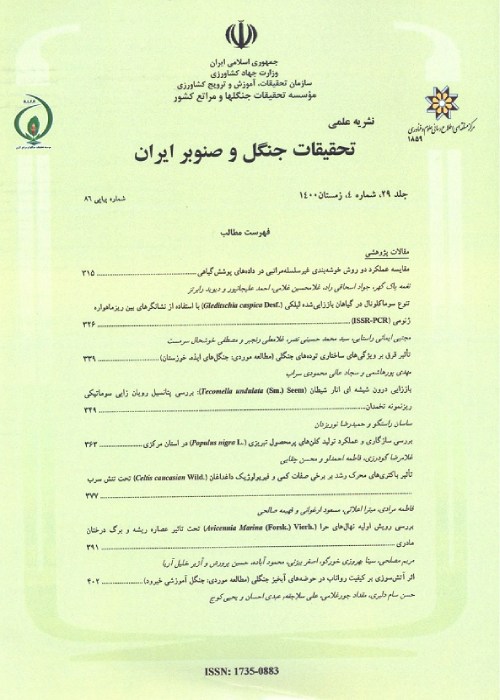Evaluation of growth and yield of black poplar (Populus nigra L.) clones under drought stress period in comparative populetum of Sanandaj
Author(s):
Article Type:
Research/Original Article (دارای رتبه معتبر)
Abstract:
Regarding the effects of climate change and the recent drought in Iran, it is necessary to assess the growth and producion of poplar varieties under drought stress. In this research, 14 clones of black poplar (Populus nigra L.) were studied during 2001-2008 in Sanandaj, Kurdistan province. Cuttings were planted in early March of 2000, and the samplings were transplanted in early April of 2001 in 3m × 3m spacing and a Randomized Complete Block Design (RCBD) with 3 replications. The yearly field works included uniformly-applied irrigation, weeding and pruning. However, they were subjected to drought stress in 2007 due to the impossibility of providing water by the tenth of July (103 days). The results showed that drought caused leaf yellowing and fall, as well as mildew (Melanophylla picta) outbreak and finally drying of a number of trees. Moreover, simultaneous drought and increase the range of traits changes limited the growth of poplar clones, so that the trees could not show their potential growth rate. Responses to drought stress among poplar clones showed a significant variation, so that P.n.M and P. n. 42/53 showed zero percentage, while P. n. 63/135 showed about 50% damage caused by drought. The average loss of drought in the clones was 20.49%. In addition, the P. n. 56/52and P. n. 56/75cloneswith 25.61 and 24.80 m3/ha per year wood yield and moderate (25-30%) damage caused by drought were defined as high-yield and relatively tolerant clones. The results of multivariate statistical analysis (correlation coefficients, cluster analysis, and principal component analysis- PCA) showed a negative effect of drought stress on the wood yield and its components. They also showed that smaller clones with fewer leaf sizes have higher drought tolerance by more water maintaining potential and lower evaporation levels. Finally, the presence of genetic diversity in terms of stress tolerance among poplar clones as well as their segregation pattern in cluster analysis and PCA biplot indicated the interference of genetic factors in its control and the availability of stable clones that can be compatible with dry conditions of the country via their hybridization.
Keywords:
Clone , function , genetic diversity , loss
Language:
Persian
Published:
Iranian Journal of Forest and Poplar Research, Volume:26 Issue: 2, 2018
Pages:
276 to 290
magiran.com/p1859524
دانلود و مطالعه متن این مقاله با یکی از روشهای زیر امکان پذیر است:
اشتراک شخصی
با عضویت و پرداخت آنلاین حق اشتراک یکساله به مبلغ 1,390,000ريال میتوانید 70 عنوان مطلب دانلود کنید!
اشتراک سازمانی
به کتابخانه دانشگاه یا محل کار خود پیشنهاد کنید تا اشتراک سازمانی این پایگاه را برای دسترسی نامحدود همه کاربران به متن مطالب تهیه نمایند!
توجه!
- حق عضویت دریافتی صرف حمایت از نشریات عضو و نگهداری، تکمیل و توسعه مگیران میشود.
- پرداخت حق اشتراک و دانلود مقالات اجازه بازنشر آن در سایر رسانههای چاپی و دیجیتال را به کاربر نمیدهد.
دسترسی سراسری کاربران دانشگاه پیام نور!
اعضای هیئت علمی و دانشجویان دانشگاه پیام نور در سراسر کشور، در صورت ثبت نام با ایمیل دانشگاهی، تا پایان فروردین ماه 1403 به مقالات سایت دسترسی خواهند داشت!
In order to view content subscription is required
Personal subscription
Subscribe magiran.com for 70 € euros via PayPal and download 70 articles during a year.
Organization subscription
Please contact us to subscribe your university or library for unlimited access!


